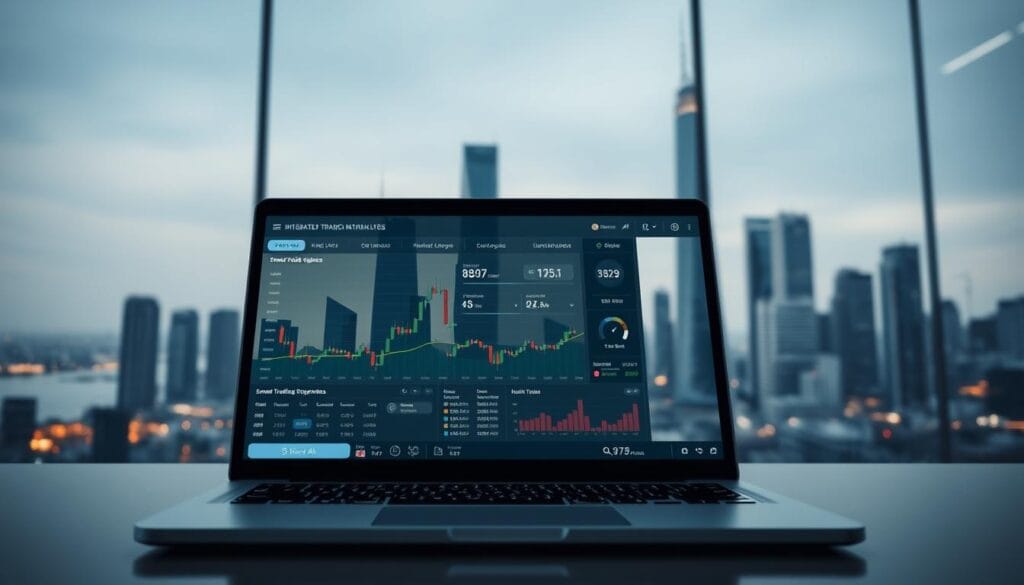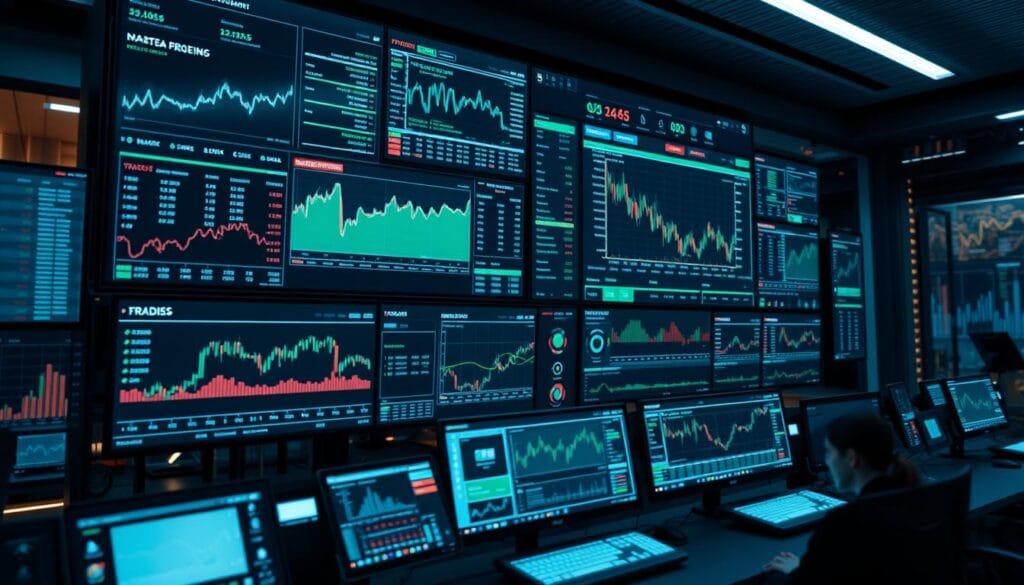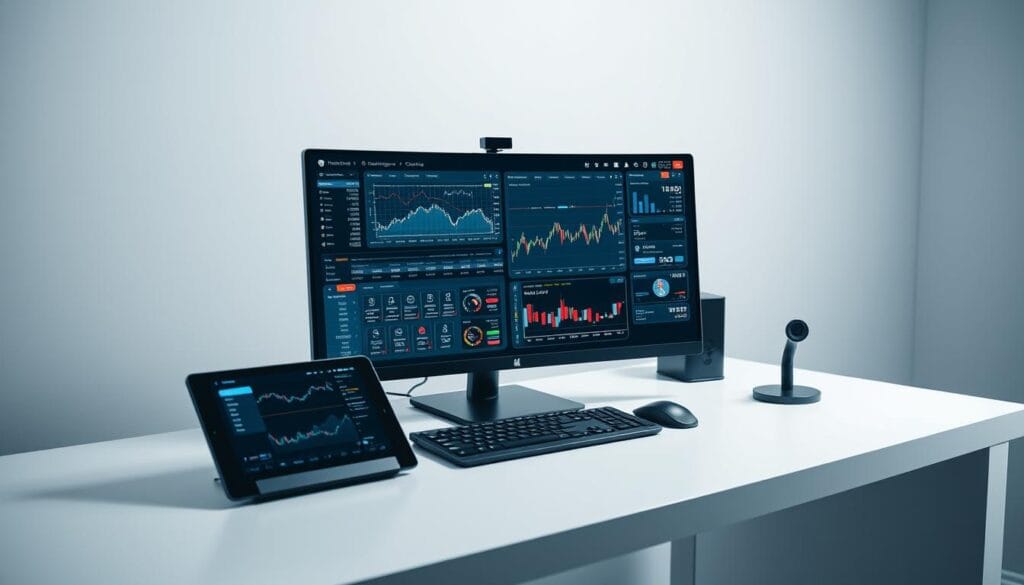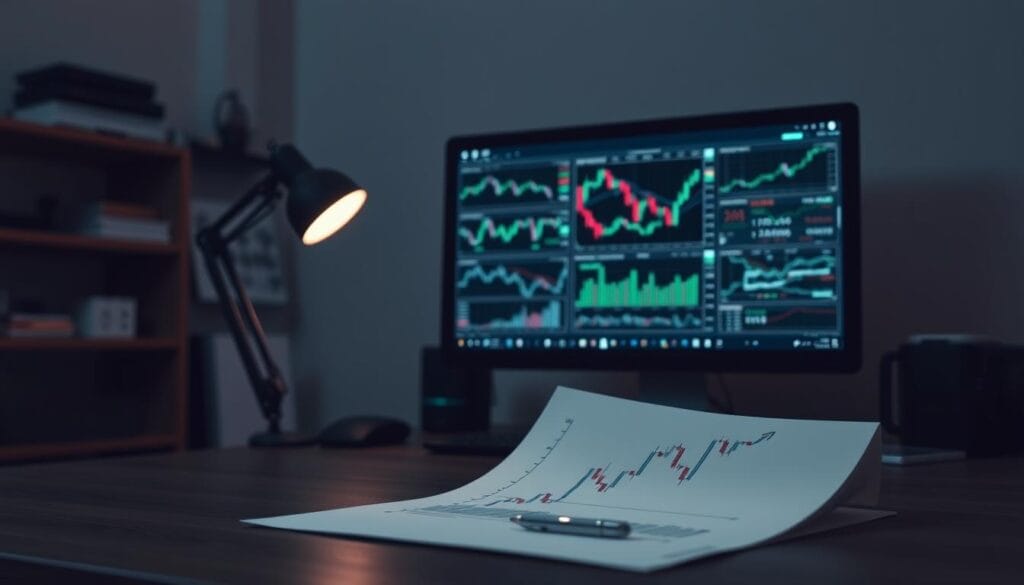Algorithmic trading powered by artificial intelligence has reshaped global financial markets, with institutions leveraging machine learning to process petabytes of market data daily. These systems analyze patterns across decades of historical performance while monitoring real-time price movements, executing transactions at speeds impossible for human traders.
Modern platforms employ neural networks that adapt to evolving market conditions, identifying opportunities through sentiment analysis of news feeds and social media. Providers like IG International Limited have integrated these tools into user-friendly interfaces, democratizing access to institutional-grade strategies.
While automated systems reduce emotional decision-making, they require careful calibration. Historical incidents like the 2010 Flash Crash underscore the importance of regulatory safeguards and system redundancy protocols. New traders must understand both the predictive power and limitations of these technologies.
Key Takeaways
- Algorithmic systems process billions of data points to identify trading patterns
- Real-time analysis enables execution speeds measured in microseconds
- Risk management protocols remain critical for system reliability
- Regulatory frameworks continue evolving with technological advances
- Historical performance data informs predictive model development
Understanding AI Trading Fundamentals

Modern financial markets increasingly rely on computational systems that transform raw data into strategic insights. These platforms utilize machine learning to analyze historical trends and real-time fluctuations, enabling precise execution across diverse markets. By integrating advanced algorithms, traders identify patterns imperceptible to manual analysis.
What Is AI Trading?
This approach combines quantitative analysis with self-improving algorithms to interpret complex data streams. Machine learning models detect subtle correlations between macroeconomic indicators, price movements, and news sentiment. Unlike rule-based automation, these systems evolve their intelligence through continuous feedback loops.
Benefits for Beginner Traders
Novices gain institutional-grade tools that automate technical analysis while enforcing risk controls. Platforms using adaptive algorithms scan global markets for high-probability opportunities 24/7. This eliminates emotional decision-making and provides structured entry/exit protocols tailored to individual risk tolerances.
How do I start AI trading?

Embarking on automated trading requires foundational preparation across three pillars: account setup, asset strategy, and system configuration. Verified accounts on regulated platforms form the operational backbone, requiring identity confirmation and security protocols. Financial guidance tools assist in aligning platform choices with individual risk profiles and investment horizons.
Strategic asset selection separates sustainable portfolios from volatile experiments. Diversification across uncorrelated markets—equities, commodities, and currencies—buffers against sector-specific turbulence. “Concentration builds wealth; diversification preserves it,” observes a J.P. Morgan analysis of decade-long market trends.
Comprehensive investment scrutiny precedes automation activation. Traders dissect historical performance metrics, volatility indices, and liquidity thresholds through quantitative analysis frameworks. This data-driven approach informs algorithmic parameters, ensuring systems mirror predefined risk-reward ratios.
Final automation checks involve simulated trading environments and fail-safe triggers. Platforms like Interactive Brokers validate execution speeds and order accuracy using synthetic markets. Only after confirming 99.9% system reliability should traders transition to live asset allocation.
These preparatory stages—from account authentication to strategy validation—establish the scaffolding for informed market participation. While automation streamlines execution, human oversight remains indispensable for adapting to black swan events and regulatory shifts.
Choosing the Right AI Trading Platform

Retail investors must prioritize platform reliability and security when adopting automated strategies. The ideal system balances advanced analytics with intuitive design, enabling users to execute trades efficiently while managing risks. Performance metrics like order execution speed and uptime percentages often separate market leaders from outdated solutions.
Evaluating Vendor Reputation
Established providers with regulatory compliance histories offer greater stability for retail participants. Traders should verify FINRA registrations and review third-party audits. User forums and industry guides provide insights into platform reliability during volatile market conditions.
Analyzing Platform Features and Pricing
Execution speeds below 50 milliseconds and customizable dashboards enhance time-sensitive decision-making. Transparent fee structures prevent hidden costs from eroding profits. Next-gen robo-advisors often include backtesting tools that simulate strategies across historical market cycles.
Assessing Security Measures and Compliance
Bank-grade encryption and two-factor authentication protect sensitive financial data. Platforms adhering to SOC 2 Type II standards demonstrate rigorous security protocols. Regular penetration testing ensures defenses evolve alongside emerging cyber threats.
Comprehensive guides and video tutorials accelerate mastery of platform-specific tools. These resources help traders optimize strategy configurations while maintaining compliance with exchange regulations. Periodic performance reviews ensure systems adapt to shifting market dynamics without manual intervention.
Setting Up Your AI Trading Account and Tools

Modern trading platforms have streamlined technical complexities, allowing people to connect exchange accounts within minutes. Secure API integration enables real-time synchronization of market data while maintaining robust encryption standards. This operational foundation supports continuous price tracking and adaptive strategy execution across global markets.
Connecting Your Account to Exchanges
Platforms like WunderTrading simplify authentication through OAuth protocols. Users generate API keys with predefined permissions, limiting access to trade execution without withdrawal rights. Always verify exchange compatibility and test connectivity through demo accounts before live deployment.
Real-time news integration enhances decision-making by correlating price fluctuations with economic events. Configure custom alerts for specific asset thresholds to respond swiftly to market shifts. People managing multiple portfolios often utilize centralized dashboards to monitor cross-exchange results simultaneously.
Navigating User-Friendly Interfaces
Intuitive design principles help people monitor critical metrics without technical expertise. Color-coded price charts and volatility indicators enable quick analysis of emerging trends. Most platforms offer customizable widgets for tracking losses through risk/reward ratios and position sizing calculators.
Automated tools excel at processing news feeds and social sentiment data. Set conditional orders that trigger based on predefined price movements or volume spikes. Regular reviews of strategy results against market benchmarks help refine approaches over time.
Beginners should leverage beginner-friendly investment apps offering guided workflows for account configuration. These solutions often include prebuilt templates for loss mitigation and results tracking. People implement these systems effectively by starting with small positions while mastering price alert customization and news filtering techniques.
Advanced platforms provide granular control over trade execution parameters. Implement two-factor authentication and weekly audit logs to maintain account integrity. Consistent monitoring of performance results ensures systems adapt to evolving market conditions while minimizing unexpected losses.
Developing AI-Driven Trading Strategies

Sophisticated algorithms now enable traders to craft personalized approaches that balance risk and reward. These systems analyze market volatility, liquidity trends, and economic indicators to identify high-probability opportunities. By combining predictive analytics with adaptive learning, trading bots evolve strategies that outperform static models.
Portfolio Optimization Techniques
Diversification remains central to sustainable growth. Advanced platforms use Monte Carlo simulations to test asset allocations against thousands of market scenarios. This data-driven approach minimizes exposure while maximizing profits through uncorrelated investments.
Trading bots automate position sizing and rebalancing across multiple exchanges. For example, WunderTrading’s algorithms adjust allocations based on real-time volatility spikes. “The best systems act like chess masters—thinking five moves ahead,” notes a Goldman Sachs report on automated investing.
Successful strategies align with individual goals through customizable parameters. Automated portfolio management systems let users define profit targets, drawdown limits, and sector preferences. Regular backtesting against historical crises ensures robustness during turbulent periods.
Three practices enhance strategy effectiveness:
- Calibrate bots to execute trades during optimal liquidity windows
- Monitor correlation matrices to prevent overexposure
- Update risk models quarterly using fresh market data
Platforms with machine learning capabilities automatically refine entry points based on shifting conditions. Traders who combine these tools with disciplined investing principles often achieve consistent results. However, human oversight remains crucial when geopolitical events disrupt algorithmic assumptions.
Utilizing Backtesting and Analytics for AI Trading

Advanced analytics empower traders to validate approaches before risking capital. Backtesting frameworks simulate strategies across decades of market cycles, identifying patterns that drive consistent results. This process filters out flawed logic by stress-testing algorithms against historical crashes and bull markets.
Testing Strategies with Historical Data
Machine learning models analyze thousands of variables across past trades to refine entry signals. Platforms like Quantified Strategies automate this process, comparing hypothetical outcomes with real-world results. Traders gain insights into strategy durability through metrics like maximum drawdown and risk-adjusted returns.
Adaptive algorithms improve through iterative learning. They detect subtle correlations between news events and price movements missed during manual analysis. Over time, these systems optimize position sizing and timing based on evolving financial markets.
Monitoring Performance Metrics
Real-time dashboards track critical indicators like Sharpe ratios and win rates. Effective trading tools flag deviations from expected results, enabling swift adjustments. Custom alerts notify users when volatility exceeds predefined thresholds or liquidity drops.
Three metrics separate robust strategies from fragile ones:
- Profit consistency across market phases
- Correlation with benchmark indices
- Recovery speed after drawdowns
Machine learning enhances this oversight by predicting future performance based on current trends. Regular audits ensure alignment with original risk parameters while allowing strategic evolution. Traders combine these analytics with fundamental research to maintain adaptability in shifting financial markets.
Risk Management and Best Practices in AI Trading
Effective risk protocols separate sustainable trading operations from speculative ventures. Automated systems require layered safeguards to navigate volatile markets. Retail traders and institutional investors alike benefit from predefined thresholds that balance opportunity with capital preservation.
Implementing Stop-Loss Orders and Adjustments
Dynamic stop-loss mechanisms automatically exit positions when prices breach safety margins. Platforms like MetaTrader allow trailing stops that adjust with favorable price movements. One Goldman Sachs study found these tools reduce drawdowns by 37% during market shocks.
Retail traders often set fixed percentages (3-5%) per trade, while institutions use volatility-based calculations. Regular adjustments ensure alignment with shifting market conditions. “Static risk parameters become liabilities in evolving markets,” notes a BlackRock risk management whitepaper.
Customizing Risk Parameters
Sophisticated dashboards let users define position sizes, daily loss limits, and sector exposure caps. Social media sentiment feeds can trigger automatic reductions during hype cycles. For example, abnormal Twitter activity around a stock might activate tighter spreads.
Three customization principles enhance resilience:
- Scale positions relative to account size and volatility
- Integrate macroeconomic event calendars into risk models
- Conduct weekly reviews of strategy effectiveness
Institutional investors often employ machine learning to predict correlation risks across asset classes. Retail traders get started using preset templates that gradually introduce complexity. Both groups monitor social media trends alongside traditional indicators to anticipate sudden liquidity shifts.
Leveraging Market Data, News, and Sentiment Analysis
Market dynamics now demand instant interpretation of information streams across global exchanges. Advanced tools synthesize price charts, economic indicators, and social chatter into actionable signals. This fusion enables traders to anticipate volatility shifts before they manifest in asset prices.
Integrating Real-Time Market Data
Platforms like WunderTrading process live feeds from 87 exchanges, updating bid-ask spreads every 300 milliseconds. These systems flag trading opportunities through pattern recognition across currency pairs and commodity markets. API integrations allow bots to execute orders when liquidity peaks, maximizing fill rates.
Using Social Media and News Insights
Sentiment engines analyze 500,000 news articles and social posts daily, scoring market mood on a -1 to +1 scale. During the 2023 banking crisis, these tools detected rising anxiety 14 hours before regional bank stocks collapsed. “Algorithms now parse fear and greed better than most analysts,” states a Goldman Sachs report on behavioral finance.
Three practices enhance data utilization:
- Configure bots to cross-verify social trends with on-chain metrics
- Set geo-targeted news filters for localized market impacts
- Use demo accounts to refine alert thresholds risk-free
Novice traders should test strategies through simulated environments before live deployment. Platforms offering paper trading replicate real-world slippage and order delays. This preparation builds confidence in handling sudden news-driven trading opportunities.
“Data synthesis separates reactive gamblers from proactive strategists.”
By combining these tools, traders transform raw information into structured decision frameworks. The most successful systems balance algorithmic speed with human-curated news filters, creating adaptable approaches for shifting market regimes.
Conclusion
The integration of intelligent systems into financial markets offers unprecedented precision in executing trades across asset classes. By adopting strategies discussed—from selecting regulated platforms to refining risk protocols—traders gain institutional-grade tools for navigating volatile crypto and equity markets.
Success hinges on methodical execution. Secure account setups, diversified asset allocations, and adaptive algorithms form the foundation. Continuous learning remains vital as market dynamics evolve, requiring periodic recalibration of automated systems.
Leading platforms empower users with real-time analytics and sentiment tracking, transforming raw data into actionable decisions. However, human oversight ensures strategies adapt to black swan events that challenge algorithmic assumptions.
Traders should view these tools as enhancements to—not replacements for—critical thinking. Pairing automated execution with disciplined analysis creates sustainable pathways for long-term growth. As markets advance, those mastering this synergy will maintain competitive edges across traditional and emerging sectors like crypto.

